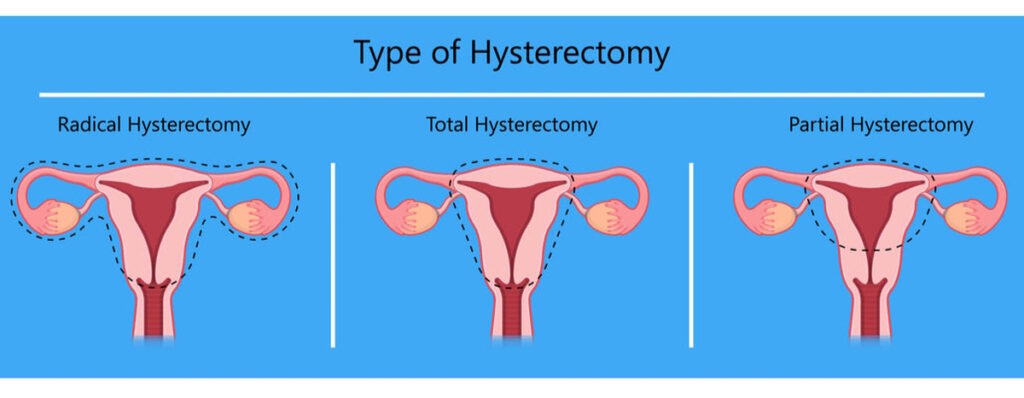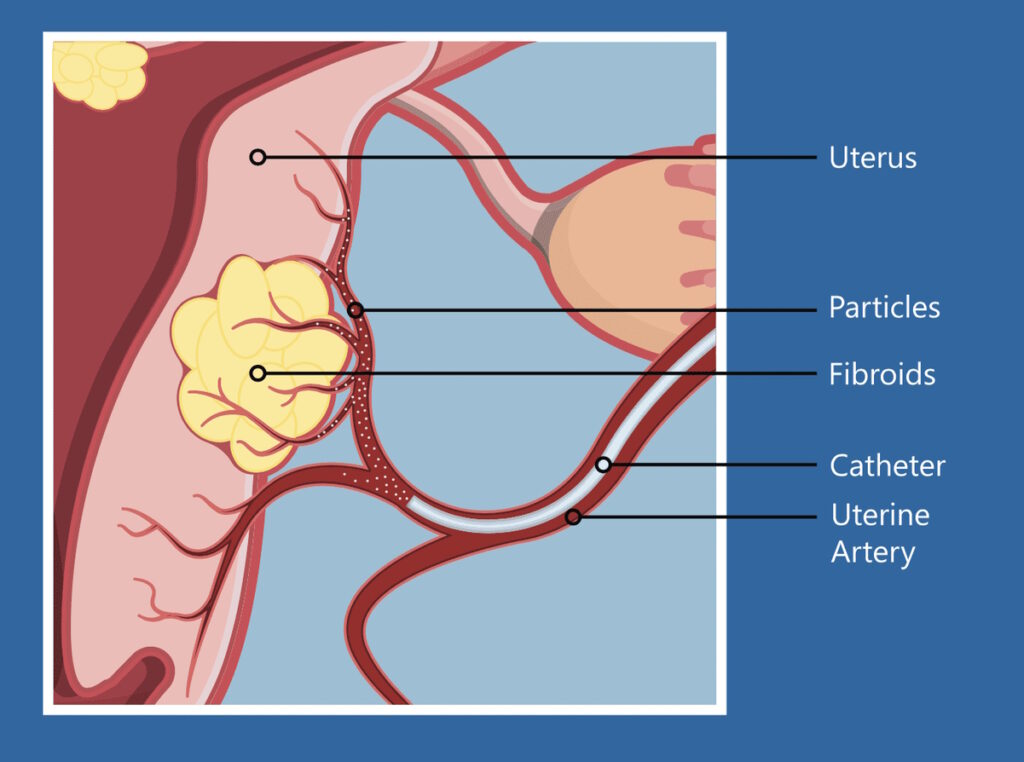Do you have heavy bleeding, irregular periods, and painful cramping due to uterine fibroids and struggle to find a solution to get back to enjoying your life? In these situations, your doctor might be quick to recommend a hysterectomy. But is going down the path to fibroid surgery the only option?
Fibroids are non-cancerous growths that develop from the muscle tissue of the uterus. And by the age of 60, one in every three women will have had this surgical procedure. It is true that a hysterectomy has historically been the surgical recommendation for fibroid treatment. But it also involves removing your uterus. That’s a decision most woman do not take lightly.
Undergoing a hysterectomy might be the best option for your unique situation. And if so, it can remove your fibroids and help you live symptom-free. What many women might not realize, though, is how drastically it affects their bodies and that alternatives to fibroid surgery do exist. Many of these questions may already be running through your mind right now: Is it absolutely necessary? How does it affect my health? Are there other alternatives to fibroid treatment?
Before you move forward, get all the facts about having a hysterectomy.
Were You Referred for a Hysterectomy to Relieve These Fibroid Symptoms?
- Heavy or long-lasting menstrual bleeding
- Debilitating cramps, pelvic pain, and pressure
- Pain during sexual intercourse
- Bloating or swelling in the lower abdomen
- Back or leg pain
- Urinary frequency
- Constipation, diarrhea, and rectum discomfort
- Fatigue with or without anemia
The Real Truth About a Hysterectomy
A hysterectomy is a way to treat fibroids as well as unrelated threats of cancer. It can be very effective, especially with fibroids. Everywhere fibroids could possibly grow and cause discomfort, a hysterectomy removes that situation. This fibroid surgery can include all or part of a woman’s uterus and, in some cases, the fallopian tubes and ovaries.
A hysterectomy can be performed through the vagina, abdomen, or laparoscopically. There is almost no chance of fibroids returning after this procedure. Your doctor may recommend one of three types of hysterectomies.
- Partial hysterectomy — Only part of the uterus and possibly the ovaries are removed. The cervix remains intact.
- Total hysterectomy — The uterus and cervix are removed. The fallopian tubes and ovaries will likely be removed.
- Radical hysterectomy — The uterus, cervix, and its surrounding tissue are removed, including the upper part of the vagina. The fallopian tubes and ovaries may or may not be removed.

While having this surgery sounds good in theory, there are a few things your doctor may not be telling you.
Hysterectomy: What Your Doctor Might Not Tell You
According to a study published in the American Journal of Obstetrics & Gynecology, as many as 1 in 5 women in the United States whose doctor recommended a hysterectomy don’t need one. Meanwhile, the same researchers found that 37.7% of women included in the study had no documentation indicating they underwent alternative treatment prior to undergoing a hysterectomy.
If you are considering hysterectomy, here are 7 more facts you need to know:
- With the exception of cancer or endometriosis, there are very few reasons to remove the uterus. Furthermore, while a hysterectomy can remove these threats, it does not guarantee the pain will be gone.
- Leaving the ovaries behind doesn’t mean they will continue to make hormones like they used to when the uterus was still there. The reality is that they lose half of their blood supply when the fallopian tubes are removed. Removing the ovaries can also decrease sex drive because the ovaries produce half of your testosterone.
- It is possible to shorten the vagina too much. Normally, it circles the cervix so that when a hysterectomy is done, the vagina is sewn shut on the end that would be attached to the cervix. So, not only is the vagina shortened, but its shape is also changed, too.
- Scar tissue in the pelvis from a hysterectomy can result in pain or bowel obstruction, a surgical emergency.
- General anesthesia is a risk during a hysterectomy due to the stress it places on the heart. There is also a risk for lung infection due to a tube being inserted into your airway and blood clots from prolonged immobility.
- There are many medications and less invasive procedures that are just as effective as a hysterectomy. Examples include the surgical procedure myomectomy and the non-surgical procedure uterine fibroid embolization (UFE).
- Morcellation, or grinding up the tissue of the uterus, during a laparoscopic hysterectomy is discouraged by the FDA due to the 1 in 350 chance that an unsuspected uterine sarcoma is present. Morcellation may leave tiny fragments of tissue and cells behind. Some ASC/Hospitals won’t allow this, while others allow morcellation with a contained bag system.
A Hysterectomy May Not Be Necessary
Sometimes, there is a definite need for a hysterectomy—especially if you have cancer. But if you have fibroids, you may be a candidate for fibroid embolization treatment. Uterine fibroid embolization (UFE) is for women with fibroids who are not a candidate for surgery or who simply don’t want to have surgery. It is the most reliable way to treat fibroids with a safe and effective non-surgical procedure.
During UFE, a tiny tube is fed through the blood vessels right to the uterus, and the blood flow to all the fibroids is blocked from the inside. With blood flow having been cut off, the fibroid will shrink and die. Thus, the patient will experience a fast reduction in painful symptoms.
Women can go home the same day. Recovery time is usually 7-10 days—much less than 4-6 weeks for a hysterectomy.

Additional advantages of UFE at Fibroid Institute include:
- UFE is covered by most major medical insurance
- In-clinic procedure instead of hospital stay
- Shorter recovery period (one week in some cases)
- No scarring, no incision
- Uterus remains preserved
- Tiny wrist puncture, no need for vaginal access
- All fibroids may be treated at the same time
- No side effects of hormone therapies typically used to treat fibroids
- Highly experienced fibroid specialists
- Patients have a doctor’s mobile phone number 24/7
- Unique pain management protocol, fostering an easy recovery
- Over 90% effective in reducing fibroid symptoms
According to follow-up studies, over 90% of women who undergo uterine fibroid embolization have their fibroid-related symptoms significantly or completely resolved. This is valid for both those who have heavy menstrual cycles and those who experience bulk-related symptoms such as pelvic pain or pressure or frequent urination. Fibroids often lose 50% of their initial volume. This results in a roughly 20% decrease in their diameter. Moreover, after embolization, fibroids usually relax and stop pressing on the nearby pelvic organs.
Fibroid Institute Has 100% Fibroid-Focused Clinics
A hysterectomy removes all or part of a woman’s uterus and, in some cases, the fallopian tubes and ovaries. But it takes time to heal from a hysterectomy, and how fast you recover depends on the type of hysterectomy surgery. Thousands of women have had their fibroids treated with nonsurgical UFE and experienced lasting results.
To know for sure if UFE is right for you, Fibroid Institute Texas handles all orders for MRIs and diagnostic scans. We also manage all insurance pre-authorizations. We offer treatments in the comfort of our Dallas or Houston fibroid clinics equipped with advanced medical technology. With each UFE procedure, patients are empowered to achieve their full potential without being limited by fibroid symptoms. For many women, the UFE procedure changed their lives. Read here why so many patients who had UFE recommend Fibroid Institute to other women suffering from fibroid symptoms:

Call our Dallas fibroid clinics at 214-838-6440 or our Houston fibroid clinics at 713-903-3733 for questions about fibroids and UFE. A free 10-15 minute phone screening, determining if you are a candidate for UFE, can be the first step in your journey to becoming fibroid free. After the screening, if you qualify for UFE, you can schedule your onsite or telehealth consultation. To request an appointment, complete the form below.
This information is not a substitute for professional medical advice. Prior to starting any new treatment or if you have questions regarding a medical condition, always seek the advice of your doctor or other qualified health provider.
Fibroid Institute Texas serves the Dallas and Houston areas including Addison, Carrollton, Plano, Frisco, Craig Ranch, McKinney, Allen, Fort Worth, Grand Prairie, HEB, Arlington, Hutchins, Irving, Duncanville, DeSoto, Cedar Hill, Lancaster, Cockrell Hill, Highland Park, University Park, Park Cities, Garland, Mesquite, Richardson, Dallas, Sherman, Houston, Sugar Land, Katy, Webster, Clear Lake, The Woodlands, Universal City, Spring, Kingwood, Stafford, Conroe, Texas City, Cypress, League City, Bellaire, and more.

